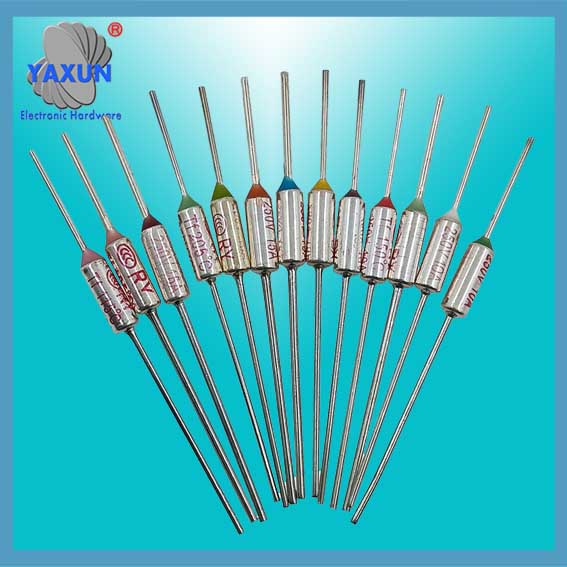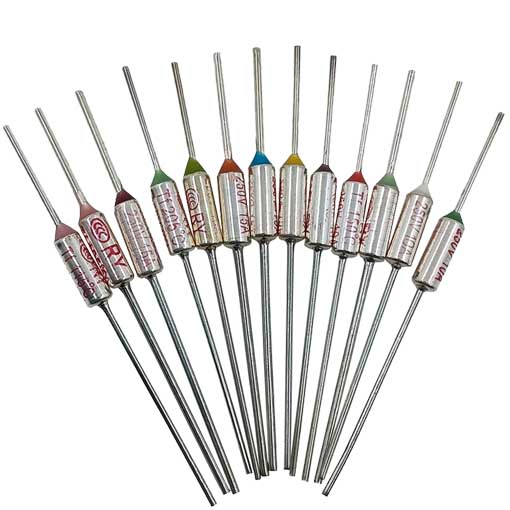produktkategori
- Termisk säkring 32
- ytmonterade säkringar 12
- termistor 36
- PCB-monterad säkringshållare 27
- Ledningsnät 6
- Bladsäkringshållare 17
- termostat 50
- Elektrisk säkring 24
- Biltemperatursensor 7
- Termisk effektbrytare 22
- Säkringsboxhållare 36
- Temperatursensor 75
- Termobrytare 68
- Bilsäkring 20
- Skruva fast säkringar 8
Produkttaggar
Tamura/NEC SF metallhölje 15A Temperatursäkring
Arbetsprincipen för AUPO / Tamura / NEC SF termisk säkring är baserad på materialets värmeutvidgning och ledande egenskaper. När temperaturen i kretsen stiger till säkringens nominella triggertemperatur, metallmaterialet i säkringen expanderar på grund av värme. När denna expansion når en viss grad, det kommer att få motståndet inuti säkringen att öka kraftigt.
Arbetsprincipen för AUPO / Tamura / NEC SF termisk säkring är baserad på materialets värmeutvidgning och ledande egenskaper. När temperaturen i kretsen stiger till säkringens nominella triggertemperatur, metallmaterialet i säkringen expanderar på grund av värme. När denna expansion når en viss grad, det kommer att få motståndet inuti säkringen att öka kraftigt. The increase in resistance will cause the fuse to heat up rapidly, further accelerating the expansion of the metal material. When the expansion reaches a certain degree, the fuse will disconnect in the circuit, thereby protecting the circuit and equipment from damage due to overheating.
Under normal circumstances, when the current passes through the thermal fuse, the fuse will maintain a low resistance state and will not affect the circuit.
When overheating occurs in the circuit, the thermal fuse begins to work. Its metal material expands due to heat, causing the resistance inside the fuse to change.
As the resistance rises, the fuse temperature rises further, accelerating the expansion of the metal material.
When the metal material expands to a certain extent, the resistance inside the fuse will rise sharply, causing the current in the circuit to be cut off.
After the fuse is disconnected, a new fuse needs to be replaced to restore the normal operation of the circuit. This is because it is difficult for the metal material to return to its original state after expansion, so that the resistance always remains high.
2. Structural features
Thermal fuse is a temperature sensing circuit cutting device with the characteristic of one-time fusing, som är, it only acts once at the fusing temperature and cannot be used again. Common types of thermal fuses include organic thermal fuses and alloy thermal fuses.
Taking the organic thermal fuse as an example, its structural features mainly include components such as temperature sensing block, compression spring and star spring. When the temperature around the organic thermal fuse rises to its operating temperature, the temperature sensing block will melt, and the compression spring will relax to make room, so that the star spring is pushed away to contact the pin, thereby disconnecting the current path. På det här sättet, the circuit will be permanently cut off.
Product Features of Thermal Fuse
SEFUSE temperature fuse installation precautions:
1. När du använder blyböjning, det bör böjas från en del mer än 6 mm from the root; Vid böjning, do not damage the roots and leads, and do not pull, trycka, or twist the leads forcibly.
2. När den termiska säkringen är fixerad av skruvar, riveting or binding posts, it should be able to prevent mechanical creep and poor contact.
3. The connecting parts should be able to work reliably within the working range of the electrical product without displacement due to vibration and shock.
4. When welding the lead wire, värmefuktigheten bör begränsas till ett minimum, and no high temperature should be applied to the thermal fuse; Dra inte med tvång, trycka, or twist the thermal fuses and leads; after soldering, cool down immediately for more than 30 sekunder.
5. The thermal fuse can only be used under the conditions of the specified rated voltage, aktuell och angiven temperatur. Pay particular attention to the maximum continuous temperature that the thermal fuse can withstand.
Notera: Nominal current, lead length and temperature can be designed according to customer requirements.
LE series Thermal Fuse (15A)
Produktegenskaper
Använder temperatursäkring av metallhölje och känner av temperatur organiska partiklar.
Tillhör termiska säkringar av oåterställbar typ. Temperatursäkringen smälter bort, även om den omgivande temperaturen sjunker, den kommer inte att slås på.
Inget bly (Pb) och kadmium (Cd), och följa RoHS.
REACH innehåller inte det specificerade 46 kategorier SVHC (SVHC).
Produktstorlek

250V 15A Temperature fuse
| Kabellängd | Mått (mm) | ||||
| A | B | C | D | E | |
| Standard LE | 4.0±0,1 | 20±3 | 10.1±3 | 35±3 | 1.0±0,1 |
| Lång LE(L) | 4.0±0,1 | 38±3 | 10.1±3 | 35±3 | 1.0±0,1 |
| Modell | Märktemperatur Tf(℃) |
Driftstemperatur (℃) |
Märkström (A) |
Märkspänning (V) |
upprätthålla temperaturen Th (℃) |
Maximal temperaturgräns Tm(℃) |
| LE070 | 73 | 71±2 | 15.0 | AC250 | 50 | 150 |
| LE073 | 77 | 74±2 | 15.0 | AC250 | 50 | 150 |
| LE080 | 84 | 80±2 | 15.0 | AC250 | 50 | 150 |
| LE090 | 94 | 91+3/-2 | 15.0 | AC250 | 65 | 150 |
| LE095 | 99 | 95±2 | 15.0 | AC250 | 71 | 150 |
| LE108 | 113 | 109±2 | 15.0 | AC250 | 85 | 150 |
| LE117 | 121 | 117±3 | 15.0 | AC250 | 95 | 160 |
| LE124 | 128 | 124±3 | 15.0 | AC250 | 102 | 160 |
| LE128 | 133 | 129+3/-2 | 15.0 | AC250 | 105 | 160 |
| LE138 | 142 | 138±3 | 15.0 | AC250 | 110 | 160 |
| LE152 | 157 | 152±2 | 15.0 | AC250 | 130 | 175 |
| LE169 | 172 | 167±2 | 15.0 | AC250 | 145 | 190 |
| LE189 | 192 | 189±3 | 15.0 | AC250 | 165 | 300 |
| LE213 | 216 | 213±2 | 15.0 | AC250 | 190 | 300 |
Kontakta oss
Väntar på ditt mejl, vi kommer att svara dig inom 12 timmar med värdefull information du behövde.
 English
English Afrikaans
Afrikaans العربية
العربية বাংলা
বাংলা bosanski jezik
bosanski jezik Български
Български Català
Català 粤语
粤语 中文(简体)
中文(简体) 中文(漢字)
中文(漢字) Hrvatski
Hrvatski Čeština
Čeština Nederlands
Nederlands Eesti keel
Eesti keel Suomi
Suomi Français
Français Deutsch
Deutsch Ελληνικά
Ελληνικά हिन्दी; हिंदी
हिन्दी; हिंदी Magyar
Magyar Bahasa Indonesia
Bahasa Indonesia Italiano
Italiano 日本語
日本語 한국어
한국어 Latviešu valoda
Latviešu valoda Lietuvių kalba
Lietuvių kalba македонски јазик
македонски јазик Bahasa Melayu
Bahasa Melayu Norsk
Norsk پارسی
پارسی Polski
Polski Português
Português Română
Română Русский
Русский Cрпски језик
Cрпски језик Slovenčina
Slovenčina Slovenščina
Slovenščina Español
Español Svenska
Svenska ภาษาไทย
ภาษาไทย Türkçe
Türkçe Українська
Українська اردو
اردو Tiếng Việt
Tiếng Việt


